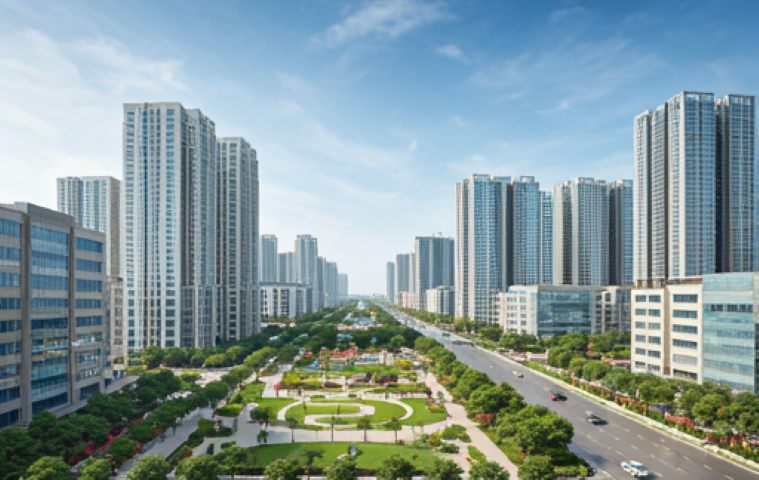INTEGRATED TOWNSHIPS ARE THE ONLY VIABLE OPTION FOR INDIAN HOUSING

The Future of Indian Housing
Akash Pharande
India’s urban population explosion is causing its bigger cities to burst at its seams. Overcrowding, pollution, traffic congestion, and deteriorating infrastructure are the ‘new normal’ – a state of affairs that we have begun to accept as inevitable.
According to the United Nations, about 40 per of the Indian population will live in urban areas by 2030. The pressure this puts on housing, transportation, and basic amenities in our cities is immense. Because of these urban ‘growing pains’, many citizens have become disillusioned with their cities and are even considering moving to smaller, less crowded, and less expensive tier 2 and tier 3 cities.
However, there are two catches to this way of thinking – one, most employment opportunities are in our larger cities. Two, the hammer of development is bound to catch up even in the smaller cities. Is there a way for citizens to regain a wholesome, uncluttered lifestyle without abandoning their cities of choice? There is.
integrated townships are the most viable alternative to traditional urban housing models. These large-scale developments are self-sustaining communities that combine residential, commercial, recreational, and educational facilities in one comprehensive layout. Unlike conventional city apartments, which are often isolated and disconnected from essential amenities, integrated townships provide a more balanced and convenient lifestyle.
Integrated townships began emerging in India during the 1980s and 1990s. Even before that, cities like Jamshedpur – founded in 1907 by the Tata Group to support their workforce – served as early examples of self-contained, self-sustaining communities. Jamshedpur was among the pioneers of integrated urban living in India where residential spaces were developed alongside recreational spaces like parks and essential services such as schools and medical facilities.
Chandigarh, planned by Le Corbusier in the 1950s, is another prime example of a development plan where housing and public facilities were created alongside commercial business centres. However, these were entire cities with their own municipalities. The concept of integrated townships – large residential complexes developed along with retail, office, civic and lifestyle developments – started gaining momentum in the 2000s.
Today, these townships have emerged as the single most transformative solution, offering a holistic living environment that promotes sustainability, convenience, and a better quality of life. They have become even more relevant if we consider the increasing chaos of modern city life.
Reduced Commuting
One of the biggest advantages of integrated townships is the proximity to workplaces, schools, healthcare facilities, shopping centres, and entertainment options. By reducing the need for long commutes, these developments save residents time and money while alleviating traffic congestion in major cities. According to one report, more than 80 per cent of homebuyers in metropolitan areas now prefer housing projects which are within a 10-kilometer radius of their workplaces.
Environmentally Friendly
Integrated townships are also designed with sustainability in mind. Green spaces, efficient waste management systems, rainwater harvesting, and renewable energy sources are increasingly becoming standard features of these developments. Integrated townships with eco-friendly infrastructure reduce carbon footprints and command a higher premium over non-sustainable developments. Moreover, by centralizing resources and infrastructure, integrated townships can reduce the strain on municipal services, thus promoting a more sustainable and resilient urban ecosystem.
Better Quality of Life
Integrated townships prioritize the well-being of their residents by offering a range of recreational and wellness facilities. From parks and sports complexes to community centres and healthcare services, these projects are designed to cater to all age groups and lifestyle preferences. They foster a sense of community and safety, with round-the-clock security and controlled access points ensuring a secure living environment.
Moreover, the availability of schools and educational institutions within the township means that families do not need to send their children far from home, reducing stress and providing a better work-life balance. Many leading minds in the real estate industry have recognized integrated townships as the future of housing, particularly in countries experiencing rapid urbanization like India.
Not surprisingly, integrated townships outperformed standalone residential projects in both price appreciation and rental yields because of the superior convenience and amenities they offer. Furthermore, the demand for integrated townships is not limited to the residential segment.
After the COVID-19 pandemic, more and more businesses have realized how important it is to have their operations closer to where their employees live. As a result, the commercial real estate segment is also seeing a surge in demand for office spaces within township developments, thanks to the growing trend of the ‘walk-to-work’ lifestyle.
Towards a Better Residential Experience
As India’s cities continue to expand, the traditional model of urban housing is proving to be increasingly untenable and homebuyers now seek alternatives that offer convenience, sustainability, and a better quality of life. Integrated townships are the answer, and will therefore account for more and more Indian residential spaces in the years to come.
Akash Pharande is Managing Director, Pharande Spaces

